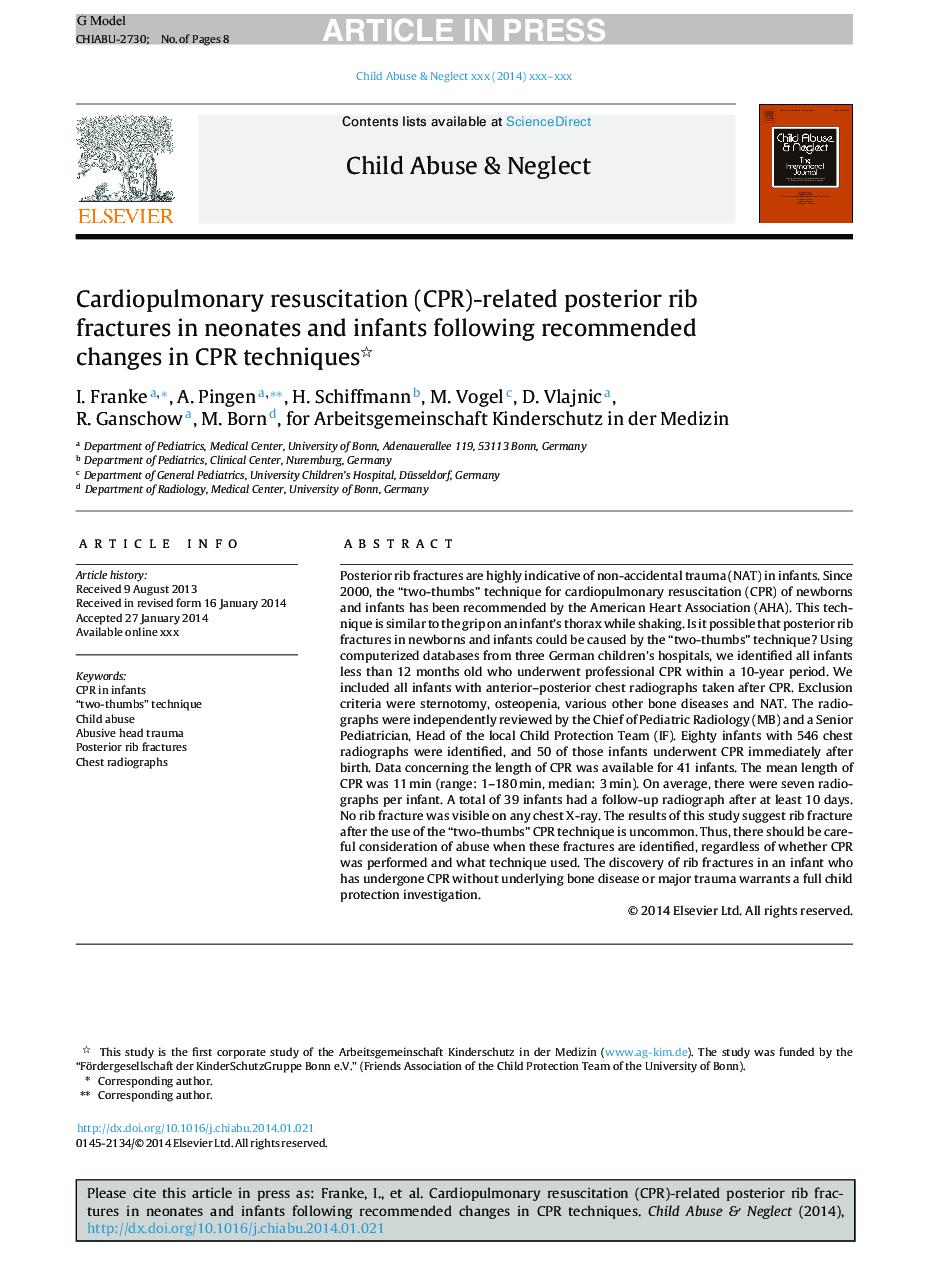| کد مقاله | کد نشریه | سال انتشار | مقاله انگلیسی | نسخه تمام متن |
|---|---|---|---|---|
| 10310715 | 617445 | 2014 | 8 صفحه PDF | دانلود رایگان |
عنوان انگلیسی مقاله ISI
Cardiopulmonary resuscitation (CPR)-related posterior rib fractures in neonates and infants following recommended changes in CPR techniques
دانلود مقاله + سفارش ترجمه
دانلود مقاله ISI انگلیسی
رایگان برای ایرانیان
کلمات کلیدی
موضوعات مرتبط
علوم پزشکی و سلامت
پزشکی و دندانپزشکی
پریناتولوژی (پزشکی مادر و جنین)، طب اطفال و بهداشت کودک
پیش نمایش صفحه اول مقاله

چکیده انگلیسی
Posterior rib fractures are highly indicative of non-accidental trauma (NAT) in infants. Since 2000, the “two-thumbs” technique for cardiopulmonary resuscitation (CPR) of newborns and infants has been recommended by the American Heart Association (AHA). This technique is similar to the grip on an infant's thorax while shaking. Is it possible that posterior rib fractures in newborns and infants could be caused by the “two-thumbs” technique? Using computerized databases from three German children's hospitals, we identified all infants less than 12 months old who underwent professional CPR within a 10-year period. We included all infants with anterior-posterior chest radiographs taken after CPR. Exclusion criteria were sternotomy, osteopenia, various other bone diseases and NAT. The radiographs were independently reviewed by the Chief of Pediatric Radiology (MB) and a Senior Pediatrician, Head of the local Child Protection Team (IF). Eighty infants with 546 chest radiographs were identified, and 50 of those infants underwent CPR immediately after birth. Data concerning the length of CPR was available for 41 infants. The mean length of CPR was 11Â min (range: 1-180Â min, median: 3Â min). On average, there were seven radiographs per infant. A total of 39 infants had a follow-up radiograph after at least 10 days. No rib fracture was visible on any chest X-ray. The results of this study suggest rib fracture after the use of the “two-thumbs” CPR technique is uncommon. Thus, there should be careful consideration of abuse when these fractures are identified, regardless of whether CPR was performed and what technique used. The discovery of rib fractures in an infant who has undergone CPR without underlying bone disease or major trauma warrants a full child protection investigation.
ناشر
Database: Elsevier - ScienceDirect (ساینس دایرکت)
Journal: Child Abuse & Neglect - Volume 38, Issue 7, July 2014, Pages 1267-1274
Journal: Child Abuse & Neglect - Volume 38, Issue 7, July 2014, Pages 1267-1274
نویسندگان
I. Franke, A. Pingen, H. Schiffmann, M. Vogel, D. Vlajnic, R. Ganschow, M. Born, for Arbeitsgemeinschaft Kinderschutz in der Medizin for Arbeitsgemeinschaft Kinderschutz in der Medizin,